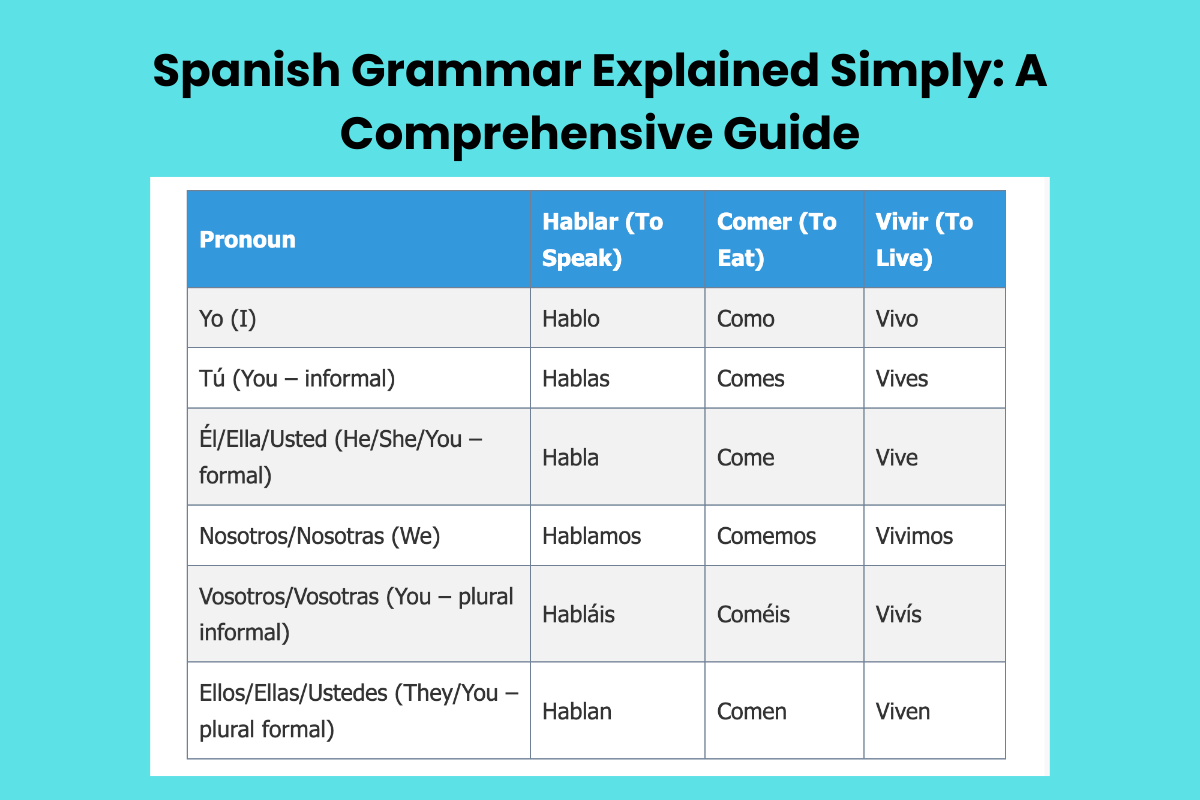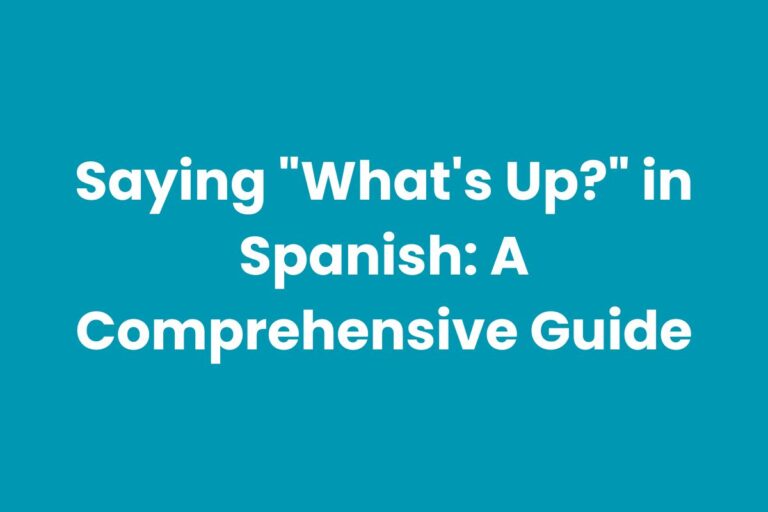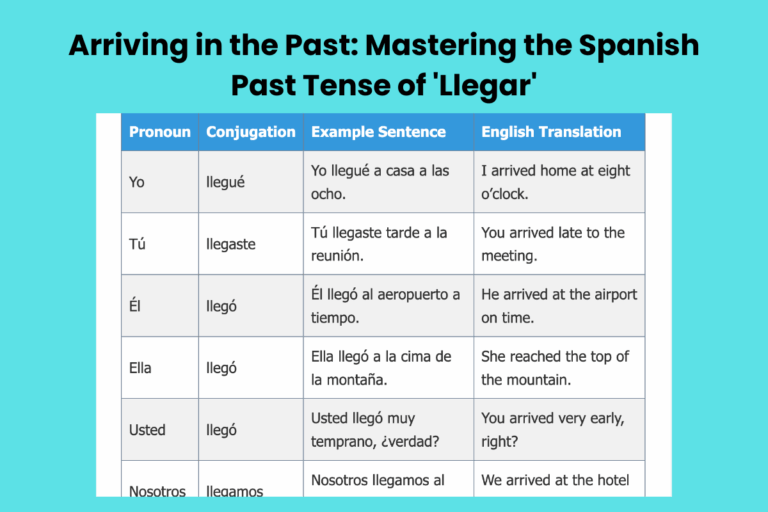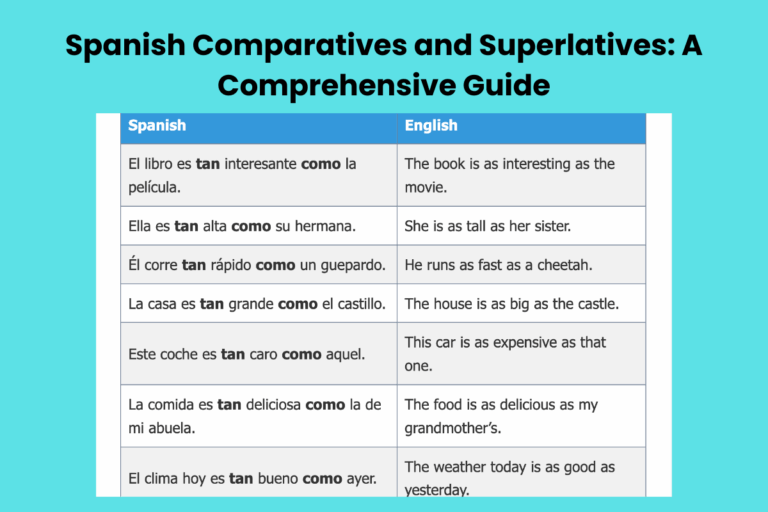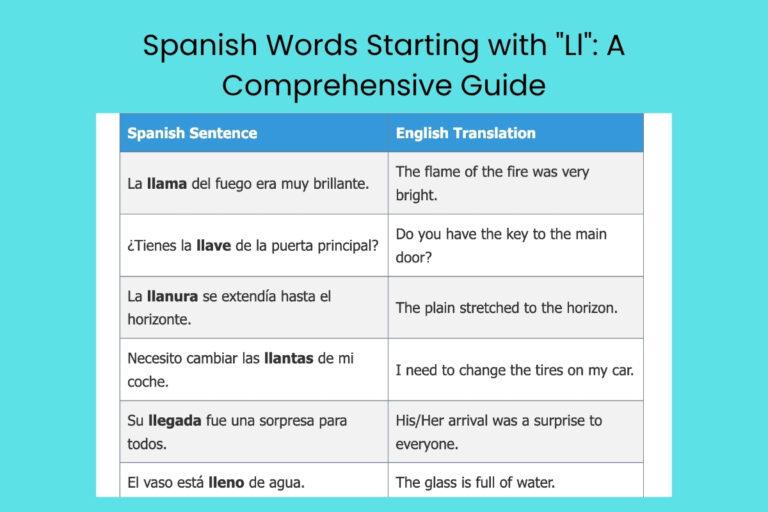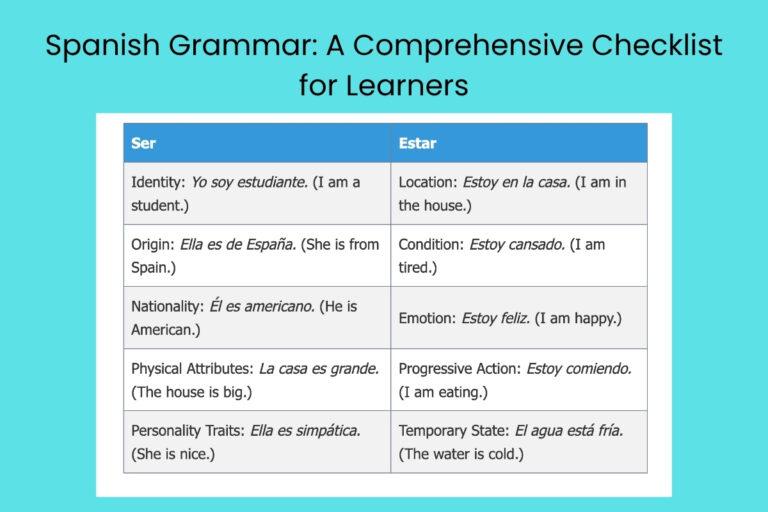Spanish Grammar Explained Simply: A Comprehensive Guide
Understanding Spanish grammar is essential for anyone looking to achieve fluency in the language. While it may seem daunting at first, breaking it down into manageable components can make the learning process much more approachable.
This guide provides a simplified explanation of key grammar concepts, offering clarity and practical examples to help you master the building blocks of Spanish. Whether you’re a beginner or an intermediate learner, this comprehensive resource will equip you with the knowledge and tools necessary to navigate the intricacies of Spanish grammar with confidence, enabling you to communicate more effectively and accurately.
This article is designed for students of all levels, from those just starting their Spanish journey to individuals looking to refine their existing skills. By focusing on core grammar principles and providing numerous examples, this guide aims to demystify Spanish grammar and make it accessible to everyone.
With clear explanations, practical exercises, and helpful tips, you’ll be well-equipped to tackle the challenges of Spanish grammar and achieve your language learning goals.
Table of Contents
- Introduction
- Definition of Spanish Grammar
- Structural Breakdown
- Nouns and Articles
- Adjectives
- Verbs
- Pronouns
- Adverbs
- Prepositions
- Sentence Structure
- Examples
- Usage Rules
- Common Mistakes
- Practice Exercises
- Advanced Topics
- FAQ
- Conclusion
Definition of Spanish Grammar
Spanish grammar, like grammar in any language, is the system of rules that govern the structure of sentences, phrases, and words in the Spanish language. It encompasses various elements, including morphology (the study of word formation), syntax (the arrangement of words in sentences), and semantics (the meaning of words and sentences).
Understanding Spanish grammar is crucial for constructing grammatically correct and meaningful sentences, allowing for effective communication and comprehension. Spanish grammar shares similarities with other Romance languages, such as French, Italian, and Portuguese, but it also possesses unique features that distinguish it.
The function of Spanish grammar is to provide a framework for organizing words and phrases in a way that conveys a clear and coherent message. It establishes the rules for verb conjugations, noun-adjective agreement, and the use of articles, pronouns, and prepositions.
Without a solid grasp of Spanish grammar, it becomes challenging to express oneself accurately and to understand the nuances of the language. Spanish grammar provides the foundation for both written and spoken communication, enabling individuals to interact effectively in various contexts, from casual conversations to formal presentations.
The context in which Spanish grammar is applied ranges from everyday interactions to academic and professional settings. In casual conversations, a basic understanding of grammar is sufficient to convey simple ideas and participate in informal discussions.
However, in more formal settings, such as writing essays or delivering presentations, a more thorough knowledge of grammar is required to ensure clarity, precision, and credibility. Spanish grammar is also essential for interpreting written texts, such as books, articles, and documents, allowing readers to extract meaning and analyze information effectively.
Structural Breakdown
The structure of Spanish grammar can be broken down into several key components: nouns, articles, adjectives, verbs, pronouns, adverbs, prepositions, and sentence structure. Each of these elements plays a crucial role in constructing grammatically correct sentences.
Nouns represent people, places, things, or ideas, while articles specify whether a noun is definite or indefinite. Adjectives describe nouns, providing additional information about their characteristics.
Verbs express actions, states, or occurrences, and they are conjugated to indicate tense, mood, and person. Pronouns replace nouns, avoiding repetition and streamlining sentences.
Adverbs modify verbs, adjectives, or other adverbs, providing information about how, when, where, or to what extent an action is performed. Prepositions indicate the relationship between nouns or pronouns and other words in the sentence.
Finally, sentence structure refers to the arrangement of words and phrases in a sentence, following specific rules to ensure clarity and coherence.
Understanding the relationships between these components is essential for mastering Spanish grammar. For example, nouns and adjectives must agree in gender and number, meaning that if a noun is masculine singular, the adjective describing it must also be masculine singular.
Similarly, verbs must agree with their subjects in number and person, meaning that the verb form must match the subject’s characteristics. The correct use of articles is also crucial, as it determines whether a noun is being referred to in a specific or general sense.
By understanding these fundamental principles, learners can construct grammatically accurate and meaningful sentences in Spanish.
In addition to these basic components, Spanish grammar also includes more complex structures, such as verb tenses and moods. Spanish has a rich system of verb tenses, including present, past, future, and conditional tenses, each of which conveys a different aspect of time.
The subjunctive mood is used to express doubt, uncertainty, or emotion, and it is often used in subordinate clauses. Mastering these more advanced structures requires a deeper understanding of Spanish grammar and a willingness to practice and experiment with different sentence patterns.
However, with consistent effort and attention to detail, learners can gradually develop the skills necessary to navigate the complexities of Spanish grammar and achieve fluency in the language.
Nouns and Articles
Gender and Number
In Spanish, nouns have gender: masculine or feminine. This gender is inherent to the noun and doesn’t necessarily reflect the object’s real-world gender. For example, libro (book) is masculine, while mesa (table) is feminine. Nouns also have number: singular or plural. To make most nouns plural, you add -s if the noun ends in a vowel, or -es if it ends in a consonant. For example, libro becomes libros, and mesa becomes mesas. If a noun ends in -z, the -z changes to -c before adding -es, such as lápiz (pencil) becoming lápices.
The gender and number of a noun affect the articles and adjectives that accompany it. This agreement is a fundamental aspect of Spanish grammar. For example, if you’re referring to “the book,” you would use the masculine singular article el: el libro. If you’re referring to “the tables,” you would use the feminine plural article las: las mesas. Understanding and applying these rules of gender and number agreement is crucial for constructing grammatically correct sentences in Spanish. This agreement ensures clarity and coherence in communication, allowing listeners and readers to easily understand the relationships between different elements in a sentence.
Exceptions to these rules exist, particularly with nouns that end in -ma, -pa, or -ta and are of Greek origin. These nouns are typically masculine, even though they end in -a. Examples include el problema (the problem) and el mapa (the map). Additionally, some nouns have the same form for both masculine and feminine, and their gender is determined by the article that accompanies them. For instance, el artista (the male artist) and la artista (the female artist). Recognizing and understanding these exceptions is essential for mastering Spanish grammar and avoiding common errors. These exceptions highlight the complexities of the language and the importance of careful attention to detail.
Definite and Indefinite Articles
Definite articles (el, la, los, las) are used to refer to specific nouns, similar to “the” in English. El is used for masculine singular nouns, la for feminine singular nouns, los for masculine plural nouns, and las for feminine plural nouns. Indefinite articles (un, una, unos, unas) are used to refer to non-specific nouns, similar to “a” or “an” in English. Un is used for masculine singular nouns, una for feminine singular nouns, unos for masculine plural nouns, and unas for feminine plural nouns.
The choice between definite and indefinite articles depends on whether the noun being referred to is specific or general. If you’re talking about a particular object or person that has already been identified, you would use a definite article. For example, El libro está en la mesa (The book is on the table). If you’re talking about a general or unspecified object or person, you would use an indefinite article. For example, Quiero un libro (I want a book). The correct use of articles is crucial for conveying the intended meaning and avoiding ambiguity in communication.
There are also cases where articles are omitted in Spanish. For example, articles are typically omitted before nouns used in general statements, after the verbs ser (to be) and tener (to have) when referring to professions or nationalities, and before certain proper nouns. For instance, Soy estudiante (I am a student), Tengo coche (I have a car), and España es un país hermoso (Spain is a beautiful country). Understanding these exceptions and nuances is essential for mastering the use of articles in Spanish and achieving fluency in the language.
Adjectives
Agreement
Adjectives in Spanish must agree in gender and number with the nouns they modify. This means that if a noun is masculine singular, the adjective must also be masculine singular. If a noun is feminine plural, the adjective must also be feminine plural. For example, el libro rojo (the red book) and las mesas rojas (the red tables). The agreement between nouns and adjectives is a fundamental aspect of Spanish grammar and is essential for constructing grammatically correct sentences.
Most adjectives have four forms: masculine singular, feminine singular, masculine plural, and feminine plural. The masculine singular form is typically the base form of the adjective. To form the feminine singular, you usually add -a to the masculine singular form. To form the masculine plural, you usually add -s to the masculine singular form. To form the feminine plural, you usually add -s to the feminine singular form. For example, alto (tall – masculine singular), alta (tall – feminine singular), altos (tall – masculine plural), altas (tall – feminine plural).
Some adjectives have irregular forms or do not change in gender. Adjectives that end in -e or a consonant typically have the same form for both masculine and feminine. For example, el hombre inteligente (the intelligent man) and la mujer inteligente (the intelligent woman). Adjectives that end in -dor, -tor, -sor change to -dora, -tora, -sora in the feminine form. For example, trabajador (hardworking – masculine) and trabajadora (hardworking – feminine). Recognizing and understanding these irregularities is crucial for mastering adjective agreement in Spanish.
Position
In Spanish, adjectives typically follow the nouns they modify. For example, el coche rojo (the red car) and la casa grande (the big house). However, there are some exceptions to this rule. Descriptive adjectives that express an inherent quality of the noun often precede the noun. For example, la blanca nieve (the white snow) and el verde césped (the green grass). Additionally, certain adjectives, such as bueno (good) and malo (bad), often precede the noun.
The position of an adjective can sometimes change the meaning of the sentence. For example, un hombre pobre (a poor man) refers to a man who lacks money, while un pobre hombre (a pitiful man) refers to a man who is unfortunate or deserving of sympathy. Similarly, una mujer grande (a big woman) refers to a woman who is physically large, while una gran mujer (a great woman) refers to a woman who is admirable or accomplished. Understanding these nuances is essential for conveying the intended meaning and avoiding misinterpretations.
The placement of adjectives can also be influenced by stylistic considerations. In more formal or literary writing, adjectives may be placed before the noun to emphasize a particular quality or create a more evocative image.
However, in most everyday situations, the standard order of noun followed by adjective is preferred. By understanding the rules and nuances of adjective position, learners can effectively use adjectives to enhance their communication and express themselves with greater precision and clarity.
Types of Adjectives
Spanish adjectives can be categorized into several types based on their function and meaning. Descriptive adjectives, as mentioned earlier, describe the qualities or characteristics of nouns. Examples include rojo (red), grande (big), pequeño (small), and inteligente (intelligent). Possessive adjectives indicate ownership or possession. Examples include mi (my), tu (your), su (his/her/its/your – formal), nuestro (our), and vuestro (your – plural informal). Demonstrative adjectives point out specific nouns. Examples include este (this), ese (that), aquel (that over there), and their corresponding feminine and plural forms.
Numerical adjectives indicate quantity or order. Cardinal numbers (uno, dos, tres) indicate quantity, while ordinal numbers (primero, segundo, tercero) indicate order. Interrogative adjectives are used to ask questions about nouns. Examples include qué (what), cuál (which), and cuánto (how much/many). Indefinite adjectives refer to nouns in a non-specific way. Examples include alguno (some), ninguno (none), mucho (much/many), and poco (little/few). Each type of adjective plays a distinct role in modifying nouns and adding detail to sentences.
Understanding the different types of adjectives is crucial for using them correctly and effectively. For example, possessive adjectives must agree in number with the noun they modify, but they do not change in gender.
Demonstrative adjectives must agree in both gender and number with the noun they modify. Numerical adjectives have specific rules for agreement and usage depending on whether they are cardinal or ordinal.
By mastering the different types of adjectives and their corresponding rules, learners can significantly enhance their ability to describe and specify nouns in Spanish.
Verbs
Regular Verbs
Regular verbs in Spanish follow predictable conjugation patterns. They are categorized into three groups based on their infinitive endings: -ar, -er, and -ir. To conjugate a regular verb, you remove the infinitive ending and add the appropriate ending for each subject pronoun. For example, the regular -ar verb hablar (to speak) is conjugated as follows in the present tense: yo hablo (I speak), tú hablas (you speak), él/ella/usted habla (he/she/you – formal speak), nosotros/nosotras hablamos (we speak), vosotros/vosotras habláis (you – plural informal speak), ellos/ellas/ustedes hablan (they/you – plural formal speak).
The conjugation patterns for regular -er and -ir verbs are also predictable, although they differ slightly from the -ar verbs. For example, the regular -er verb comer (to eat) is conjugated as follows in the present tense: yo como (I eat), tú comes (you eat), él/ella/usted come (he/she/you – formal eat), nosotros/nosotras comemos (we eat), vosotros/vosotras coméis (you – plural informal eat), ellos/ellas/ustedes comen (they/you – plural formal eat). The regular -ir verb vivir (to live) is conjugated as follows in the present tense: yo vivo (I live), tú vives (you live), él/ella/usted vive (he/she/you – formal live), nosotros/nosotras vivimos (we live), vosotros/vosotras vivís (you – plural informal live), ellos/ellas/ustedes viven (they/you – plural formal live).
Mastering the conjugation patterns for regular verbs is essential for building a solid foundation in Spanish grammar. By understanding these patterns, learners can accurately conjugate a wide range of verbs in different tenses and moods.
However, it is important to note that there are many irregular verbs in Spanish that do not follow these patterns. These irregular verbs must be memorized individually.
Nonetheless, a strong understanding of regular verb conjugations provides a valuable framework for learning and using Spanish verbs effectively.
Irregular Verbs
Irregular verbs in Spanish do not follow the standard conjugation patterns of regular verbs. They often have stem changes, irregular endings, or both. Some common irregular verbs include ser (to be), estar (to be), tener (to have), ir (to go), and hacer (to do/make). These verbs are essential for everyday communication, so it is crucial to memorize their conjugations.
Stem-changing verbs are a type of irregular verb in which the stem vowel changes in certain forms. For example, the verb pensar (to think) changes its stem vowel from e to ie in the present tense for all forms except nosotros and vosotros: yo pienso (I think), tú piensas (you think), él/ella/usted piensa (he/she/you – formal thinks), nosotros/nosotras pensamos (we think), vosotros/vosotras pensáis (you – plural informal think), ellos/ellas/ustedes piensan (they/you – plural formal think). Other common stem-changing verbs include poder (to be able to), querer (to want), and dormir (to sleep).
Verbs with irregular yo forms have an irregular conjugation only in the yo (I) form of the present tense. For example, the verb hacer (to do/make) has an irregular yo form: yo hago (I do/make). The other forms of the verb are regular. Other common verbs with irregular yo forms include saber (to know), ver (to see), and poner (to put). Mastering the conjugations of irregular verbs is essential for achieving fluency in Spanish. While it may require memorization and practice, the ability to use these verbs correctly will significantly enhance your communication skills.
Verb Tenses
Spanish has a rich system of verb tenses that allow you to express actions in the past, present, and future. The present tense (presente) is used to describe actions happening now or habitual actions. The preterite tense (pretérito) is used to describe completed actions in the past. The imperfect tense (imperfecto) is used to describe ongoing or habitual actions in the past. The future tense (futuro) is used to describe actions that will happen in the future.
The conditional tense (condicional) is used to express what would happen under certain conditions. The present perfect tense (pretérito perfecto) is used to describe actions that started in the past and continue to the present or have relevance to the present. The past perfect tense (pretérito pluscuamperfecto) is used to describe actions that happened before another action in the past. Each tense has its own set of conjugations and usage rules.
Understanding the nuances of each tense is crucial for conveying the intended meaning and avoiding confusion. For example, the preterite and imperfect tenses are both used to describe actions in the past, but they convey different aspects of time.
The preterite is used for completed actions with a definite beginning and end, while the imperfect is used for ongoing or habitual actions with no specific end point. By mastering the different verb tenses and their corresponding rules, learners can effectively express a wide range of actions and events in Spanish.
Pronouns
Subject Pronouns
Subject pronouns in Spanish indicate who is performing the action of the verb. The Spanish subject pronouns are: yo (I), tú (you – informal), él (he), ella (she), usted (you – formal), nosotros/nosotras (we), vosotros/vosotras (you – plural informal), ellos/ellas (they), and ustedes (you – plural formal). The choice of pronoun depends on the context and the relationship between the speaker and the person being addressed.
In Spanish, subject pronouns are often omitted because the verb conjugation indicates the subject. For example, instead of saying Yo hablo español (I speak Spanish), it is common to simply say Hablo español. However, subject pronouns are used for emphasis, clarification, or when the verb form does not clearly indicate the subject. For instance, Él es alto (He is tall) emphasizes that it is “he” who is tall, not someone else.
The use of tú and usted, and vosotros and ustedes, depends on the level of formality. Tú and vosotros are used in informal situations with friends, family, and peers, while usted and ustedes are used in formal situations with people you don’t know well, people of authority, or older people. Choosing the correct pronoun is essential for showing respect and maintaining appropriate social etiquette.
Object Pronouns
Object pronouns in Spanish replace nouns that are the direct or indirect object of a verb. Direct object pronouns receive the action of the verb, while indirect object pronouns indicate to whom or for whom the action is done. The direct object pronouns are: me (me), te (you – informal), lo (him/it – masculine), la (her/it – feminine), nos (us), os (you – plural informal), los (them – masculine), and las (them – feminine). The indirect object pronouns are: me (to/for me), te (to/for you – informal), le (to/for him/her/you – formal), nos (to/for us), os (to/for you – plural informal), and les (to/for them/you – plural formal).
Object pronouns typically precede the conjugated verb in Spanish. For example, Yo lo veo (I see him/it – masculine) and Ella me da el libro (She gives me the book). However, when the verb is an infinitive, gerund, or affirmative command, the object pronoun is attached to the end of the verb. For example, Quiero verlo (I want to see him/it – masculine), Está leyéndolo (He/She is reading it – masculine), and Dámelo (Give it to me).
When both a direct and indirect object pronoun are used in the same sentence, the indirect object pronoun comes before the direct object pronoun. If both pronouns begin with the letter “l,” the indirect object pronoun le or les changes to se. For example, Yo le doy el libro a Juan (I give the book to Juan) becomes Yo se lo doy (I give it to him). Understanding the placement and usage of object pronouns is essential for constructing grammatically correct and natural-sounding sentences in Spanish.
Reflexive Pronouns
Reflexive pronouns in Spanish are used when the subject and object of a verb are the same. They indicate that the subject is performing an action on itself. The reflexive pronouns are: me (myself), te (yourself – informal), se (himself/herself/itself/yourself – formal), nos (ourselves), os (yourselves – plural informal), and se (themselves/yourselves – plural formal). Reflexive pronouns are used with reflexive verbs, which are verbs that describe actions people do to themselves, such as washing, dressing, or waking up.
Reflexive pronouns typically precede the conjugated verb in Spanish. For example, Yo me lavo las manos (I wash my hands) and Ella se viste (She gets dressed). However, when the verb is an infinitive, gerund, or affirmative command, the reflexive pronoun is attached to the end of the verb. For example, Necesito ducharme (I need to shower), Está vistiéndose (He/She is getting dressed), and Siéntate (Sit down).
Some verbs can be used both reflexively and non-reflexively, but their meaning changes depending on whether a reflexive pronoun is used. For example, lavar means “to wash,” while lavarse means “to wash oneself.” Similarly, dormir means “to sleep,” while dormirse means “to fall asleep.” Recognizing and understanding the difference between reflexive and non-reflexive verbs is essential for conveying the intended meaning and avoiding confusion.
Adverbs
Types of Adverbs
Adverbs in Spanish modify verbs, adjectives, or other adverbs, providing information about how, when, where, or to what extent an action is performed. There are several types of adverbs, including adverbs of manner, adverbs of time, adverbs of place, and adverbs of degree. Adverbs of manner describe how an action is performed. Examples include rápidamente (quickly), lentamente (slowly), bien (well), and mal (badly). Adverbs of time indicate when an action occurs. Examples include ahora (now), ayer (yesterday), mañana (tomorrow), and siempre (always).
Adverbs of place indicate where an action occurs. Examples include aquí (here), allí (there), cerca (near), and lejos (far). Adverbs of degree indicate the intensity or extent of an action or quality. Examples include muy (very), poco (little), mucho (much), and bastante (enough). Understanding the different types of adverbs is crucial for using them correctly and effectively.
Many adverbs in Spanish are formed by adding the suffix -mente to the feminine singular form of an adjective. For example, rápido (quick) becomes rápidamente (quickly), and lento (slow) becomes lentamente (slowly). However, there are also many common adverbs that do not follow this pattern, such as bien (well), mal (badly), aquí (here), and ahora (now). These adverbs must be memorized individually. By mastering the different types of adverbs and their corresponding forms, learners can significantly enhance their ability to describe and specify actions and qualities in Spanish.
Adverbial Phrases
Adverbial phrases are groups of words that function as adverbs, modifying verbs, adjectives, or other adverbs. They provide additional information about how, when, where, or to what extent an action is performed. Adverbial phrases can be formed using prepositions, nouns, adjectives, or adverbs. Examples of adverbial phrases include a menudo (often), de repente (suddenly), en silencio (silently), and con cuidado (carefully).
Adverbial phrases can add detail and nuance to sentences, making them more descriptive and informative. For example, instead of saying Ella cantó bien (She sang well), you could say Ella cantó con mucho entusiasmo (She sang with a lot of enthusiasm). The adverbial phrase con mucho entusiasmo provides more information about how she sang.
Understanding and using adverbial phrases is essential for achieving fluency in Spanish. They allow you to express yourself with greater precision and clarity, and they add richness and variety to your language.
By learning common adverbial phrases and practicing their usage, learners can significantly enhance their communication skills.
Prepositions
Prepositions in Spanish are words that connect nouns, pronouns, or phrases to other words in a sentence, indicating relationships such as location, direction, time, or manner. Some common Spanish prepositions include a (to, at), de (of, from), en (in, on, at), para (for, to), por (for, by), con (with), sin (without), sobre (on, about), and entre (between, among). Each preposition has its own specific meaning and usage rules.
The preposition a is used to indicate direction, destination, or purpose. For example, Voy a la playa (I am going to the beach) and Estudio para el examen (I am studying for the exam). The preposition de is used to indicate possession, origin, or material. For example, El libro de Juan (Juan’s book) and Soy de España (I am from Spain). The preposition en is used to indicate location or time. For example, Estoy en casa (I am at home) and En verano hace calor (In summer it is hot).
The prepositions para and por are often confused because they both can translate to “for” in English. However, they have different meanings and usages. Para is used to indicate purpose, destination, or recipient. For example, Este regalo es para ti (This gift is for you) and Trabajo para ganar dinero (I work to earn money). Por is used to indicate cause, reason, or exchange. For example, Lo hago por ti (I do it for you) and Te doy esto por tu ayuda (I give you this for your help). Mastering the different prepositions and their corresponding rules is essential for constructing grammatically correct and meaningful sentences in Spanish.
Sentence Structure
The basic sentence structure in Spanish is similar to English: Subject-Verb-Object (SVO). However, Spanish is more flexible than English, and the word order can be varied for emphasis or stylistic effect. For example, Yo como manzanas (I eat apples) can also be expressed as Manzanas como yo (Apples I eat), although the latter is less common and more emphatic.
In Spanish, adjectives typically follow the nouns they modify, as mentioned earlier. For example, el coche rojo (the red car) and la casa grande (the big house). However, there are exceptions to this rule, and the position of an adjective can sometimes change the meaning of the sentence. Adverbs can be placed before or after the verb they modify, depending on the desired emphasis. For example, Ella canta bien (She sings well) and Bien canta ella (Well she sings).
Questions in Spanish can be formed by simply changing the intonation of a statement or by using interrogative words such as qué (what), quién (who), dónde (where), cuándo (when), cómo (how), and por qué (why). For example, ¿Hablas español? (Do you speak Spanish?) and ¿Qué quieres? (What do you want?). Understanding the basic sentence structure and the flexibility of word order in Spanish is essential for constructing clear and effective sentences.
Examples
This section provides a variety of examples to illustrate the grammar concepts discussed in this article. The examples are organized by category to help you understand how the different grammar elements are used in context.
Nouns and Articles Examples
The following table provides examples of nouns with their corresponding articles, demonstrating gender and number agreement.
| Noun (Singular) | Article (Singular) | Noun (Plural) | Article (Plural) |
|---|---|---|---|
| Libro (Book) | El libro | Libros (Books) | Los libros |
| Mesa (Table) | La mesa | Mesas (Tables) | Las mesas |
| Profesor (Professor) | El profesor | Profesores (Professors) | Los profesores |
| Profesora (Professor – female) | La profesora | Profesoras (Professors – female) | Las profesoras |
Adjective Examples
The following table provides examples of adjectives modifying nouns, demonstrating gender and number agreement.
| Noun (Singular) | Adjective (Singular) | Noun (Plural) | Adjective (Plural) |
|---|---|---|---|
| Coche (Car) | Coche rojo (Red car) | Coches (Cars) | Coches rojos (Red cars) |
| Casa (House) | Casa grande (Big house) | Casas (Houses) | Casas grandes (Big houses) |
| Hombre (Man) | Hombre inteligente (Intelligent man) | Hombres (Men) | Hombres inteligentes (Intelligent men) |
| Mujer (Woman) | Mujer inteligente (Intelligent woman) | Mujeres (Women) | Mujeres inteligentes (Intelligent women) |
Verb Examples
The following table provides examples of regular verbs conjugated in the present tense.
| Pronoun | Hablar (To Speak) | Comer (To Eat) | Vivir (To Live) |
|---|---|---|---|
| Yo (I) | Hablo | Como | Vivo |
| Tú (You – informal) | Hablas | Comes | Vives |
| Él/Ella/Usted (He/She/You – formal) | Habla | Come | Vive |
| Nosotros/Nosotras (We) | Hablamos | Comemos | Vivimos |
| Vosotros/Vosotras (You – plural informal) | Habláis | Coméis | Vivís |
| Ellos/Ellas/Ustedes (They/You – plural formal) | Hablan | Comen | Viven |
The following table provides examples of irregular verbs conjugated in the present tense.
| Pronoun | Ser (To Be) | Tener (To Have) | Ir (To Go) |
|---|---|---|---|
| Yo (I) | Soy | Tengo | Voy |
| Tú (You – informal) | Eres | Tienes | Vas |
| Él/Ella/Usted (He/She/You – formal) | Es | Tiene | Va |
| Nosotros/Nosotras (We) | Somos | Tenemos | Vamos |
| Vosotros/Vosotras (You – plural informal) | Sois | Tenéis | Vais |
| Ellos/Ellas/Ustedes (They/You – plural formal) | Son | Tienen | Van |
Pronoun Examples
The following table provides examples of subject, direct object, and indirect object pronouns in sentences.
| Type of Pronoun | Example Sentence | Translation |
|---|---|---|
| Subject Pronoun | Yo hablo español. | I speak Spanish. |
| Direct Object Pronoun | Yo lo veo. | I see him/it (masculine). |
| Indirect Object Pronoun | Ella me da el libro. | She gives me the book. |
| Reflexive Pronoun | Yo me lavo las manos. | I wash my hands. |
These examples provide a practical understanding of how Spanish grammar elements are used in context. By studying these examples, you can improve your ability to construct grammatically correct and meaningful sentences in Spanish.
Usage Rules
This section outlines specific rules for using various elements of Spanish grammar, providing clear guidelines to help you avoid common mistakes and improve your accuracy.
Noun and Article Usage Rules
- Nouns must agree in gender and number with their articles and adjectives.
- Use definite articles (el, la, los, las) to refer to specific nouns.
- Use indefinite articles (un, una, unos, unas) to refer to non-specific nouns.
- Omit articles before nouns used in general statements.
- Omit articles after the verbs ser and tener when referring to professions or nationalities.
Adjective Usage Rules
- Adjectives must agree in gender and number with the nouns they modify.
- Adjectives typically follow the nouns they modify.
- Descriptive adjectives that express an inherent quality of the noun often precede the noun.
- The position of an adjective can sometimes change the meaning of the sentence.
Verb Usage Rules
- Regular verbs follow predictable conjugation patterns based on their infinitive endings (-ar, -er, -ir).
- Irregular verbs do not follow the standard conjugation patterns and must be memorized individually.
- Use the present tense to describe actions happening now or habitual actions.
- Use the preterite tense to describe completed actions in the past.
- Use the imperfect tense to describe ongoing or habitual actions in the past.
Pronoun Usage Rules
- Subject pronouns indicate who is performing the action of the verb.
- Subject pronouns are often omitted because the verb conjugation indicates the subject.
- Use tú and vosotros in informal situations, and usted and ustedes in formal situations.
- Object pronouns replace nouns that are the direct or indirect object of a verb.
- Object pronouns typically precede the conjugated verb.
- Reflexive pronouns are used when the subject and object of a verb are the same.
Adverb Usage Rules
- Adverbs modify verbs, adjectives, or other adverbs.
- Adverbs of manner describe how an action is performed.
- Adverbs of time indicate when an action occurs.
- Adverbs of place indicate where an action occurs.
- Adverbs of degree indicate the intensity or extent of an action or quality.
- Many adverbs are formed by adding -mente to the feminine singular form of an adjective.
Preposition Usage Rules
- Prepositions connect nouns, pronouns, or phrases to other words in a sentence.
- Each preposition has its own specific meaning and usage rules.
- The prepositions para and por are often confused but have different meanings and usages.
By following these usage rules, you can improve your accuracy and fluency in Spanish.
Common Mistakes
This section highlights common mistakes made by Spanish learners, providing explanations and corrections to help you avoid these errors and improve your understanding of Spanish grammar.
Gender and Number Agreement Mistakes
Mistake: El mesa
Correct: La mesa
Explanation: Mesa (table) is a feminine noun, so it must be accompanied by the feminine article la.
Mistake: Los libro
Correct: Los libros
Explanation: Libro (book) is a masculine noun, and in the plural form, it should be libros.
Adjective Agreement Mistakes
Mistake: El coche roja
Correct: El coche rojo
Explanation: Coche (car) is a masculine noun, so the adjective rojo (red) must also be masculine.
Mistake: Las casas grande
Correct: Las casas grandes
Explanation: Casas (houses) is a feminine plural noun, so the adjective grande (big) must also be feminine plural.
Verb Conjugation Mistakes
Mistake: Yo es estudiante
Correct: Yo soy estudiante
Explanation: The correct conjugation of the verb ser (to be) for the pronoun yo (I) is soy.
Mistake: Él tener un libro
Correct: Él tiene un libro
Explanation: The correct conjugation of the verb tener (to have) for the pronoun él (he) is tiene.
Pronoun Usage Mistakes
Mistake: Me llamo es Juan
Correct: Me llamo Juan
Explanation: The verb llamarse (to be called) is reflexive, and the structure is Me llamo Juan (I call myself Juan).
Mistake: Le doy el libro a María (but using “le” correctly is the goal)
Correct: Se lo doy a María or Le doy el libro
Explanation: When both the direct and indirect object pronouns starts with “l”, the indirect object pronoun (le) changes to se. If the indirect object is clear from context, it is not necessary to duplicate it at the end of the sentence (“a Maria”)
Preposition Usage Mistakes
Mistake: Voy a la casa de mi amigo
Correct: Voy a la casa de mi amigo
Explanation: The preposition a is used to indicate direction or destination.
Mistake: Estudio por ser doctor
Correct: Estudio para ser doctor
Explanation: The preposition para is used to indicate purpose or goal.
By recognizing and avoiding these common mistakes, you can improve your accuracy and fluency in Spanish.
Practice Exercises
This section provides a series of practice exercises to help you reinforce your understanding of Spanish grammar. Complete the exercises and check your answers to assess your progress.
Exercise 1: Gender and Number Agreement
Fill in the blanks with the correct article (el, la, los, las) and adjective form.
- ______ libro ______ (rojo)
- ______ mesa ______ (grande)
- ______ coches ______ (nuevo)
- ______ casas ______ (antiguo)
Answers:
- El libro rojo
- La mesa grande
- Los coches nuevos
- Las casas antiguas
Exercise 2: Verb Conjugation
Conjugate the following verbs in the present tense for the given pronouns.
- Yo ______ (hablar) español.
- Tú ______ (comer) pizza.
- Él ______ (vivir) en España.
- Nosotros ______ (ser) estudiantes.
Answers:
- Yo hablo español.
- Tú comes pizza.
- Él vive en España.
- Nosotros somos estudiantes.
Exercise 3: Pronoun Usage
Fill in the blanks with the correct pronoun (yo, tú, él, ella, me, te, lo, la).
- ______ llamo Juan.
- ______ doy el libro.
- ______ es alto.
- ______ veo en la calle.
Answers:
- Me llamo Juan.
- Te doy el libro.
- Él es alto.
- La veo en la calle.
Exercise 4: Preposition Usage
Fill in the blanks with the correct preposition (a, de, en, para, por).
- Voy ______ la playa.
- El libro es ______ Juan.
- Estoy ______ casa.
- Estudio ______ el examen.
Answers:
- Voy a la playa.
- El libro es de Juan.
- Estoy en casa.
- Estudio para el examen.
By completing these practice exercises, you can reinforce your understanding of Spanish grammar and improve your accuracy.
Advanced Topics
This section explores more advanced topics in Spanish grammar, providing insights into complex structures and nuances that can help you achieve a higher level of fluency.
Subjunctive Mood
The subjunctive mood is used to express doubt, uncertainty, emotion, or subjectivity. It is often used in subordinate clauses and after certain verbs and expressions. For example, Es importante que estudies (It is important that you study) and Dudo que venga (I doubt that he/she comes).
Conditional Sentences
Conditional sentences express what would happen under certain conditions. They typically consist of an “if” clause (protasis) and a main clause (apodosis). The verb tenses used in each clause depend on the type of condition being expressed. For example, Si tuviera dinero, viajaría (If I had money, I would travel) and Si hubiera estudiado, habría aprobado (If I had studied, I would have passed).
Passive Voice
The passive voice is used to emphasize the action rather than the actor. It is formed using the verb ser (to be) and a past participle. For example, El libro fue escrito por Juan (The book was written by Juan).
Relative Clauses
Relative clauses provide additional information about a noun in the main clause. They are introduced by relative pronouns such as que (that/which), quien (who), and cuyo (whose). For example, El hombre que vive aquí es mi vecino (The man who lives here is my neighbor).
By exploring these advanced topics, you can deepen your understanding of Spanish grammar and achieve a higher level of fluency.
FAQ
This section provides answers to frequently asked questions about Spanish grammar, addressing common concerns and misconceptions.
Why is gender agreement so important in Spanish?
Gender agreement is crucial for clarity and coherence in Spanish. It ensures that the relationships between nouns, articles, and adjectives are clear, allowing listeners and readers to easily understand the meaning of the sentence.
How can I improve my verb conjugation skills?
The best way to improve your verb conjugation skills is to practice regularly. Use flashcards, online resources, and language learning apps to memorize the conjugation patterns for regular and irregular verbs.
Also, try to use the verbs in context by writing sentences and engaging in conversations.
What is the difference between para and por?
Para is used to indicate purpose, destination, or recipient, while por is used to indicate cause, reason, or exchange. Understanding the nuances of each preposition is essential for using them correctly.
How can I avoid common mistakes in Spanish grammar?
To avoid common mistakes, focus on understanding the fundamental principles of Spanish grammar, such as gender and number agreement, verb conjugation, and pronoun usage. Practice regularly, review your work, and seek feedback from native speakers or language teachers.
Is it necessary to memorize all the irregular verbs?
While it is not necessary to memorize all the irregular verbs at once, it is important to learn the most common ones, as they are essential for everyday communication. Focus on mastering the verbs that you use most frequently and gradually expand your knowledge over time.
Conclusion
Mastering Spanish grammar is a journey that requires dedication, practice, and a willingness to learn from your mistakes. By understanding the fundamental principles of Spanish grammar, such as noun and adjective agreement, verb conjugation, and pronoun usage, you can significantly improve your ability to communicate effectively in Spanish.
This guide has provided a simplified explanation of key grammar concepts, offering clarity and practical examples to help you navigate the intricacies of the language. Remember to practice regularly, seek feedback, and embrace the challenges along the way.
With consistent effort and attention to detail, you can achieve your language learning goals and unlock the rich cultural experiences that come with fluency in Spanish.

